Using solder fittings with copper pipes
repairing a leaking solder fitting
Materials :-
- wire wool
- plumbing solder flux
- thin gauge solder
- blow torch (or suitable heat gun)
- damp cloth
- heat screen
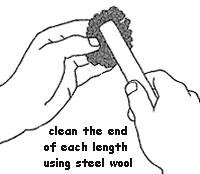 With all the pieces of pipes cut to length, the ends of each pipe (to a length of about 25mm (1 inch)) need to be cleaned back to bright metal using a piece of steel wool.
With all the pieces of pipes cut to length, the ends of each pipe (to a length of about 25mm (1 inch)) need to be cleaned back to bright metal using a piece of steel wool.
Slide each piece of pipe into the connector, make sure they go in as far as the stop in the body - if a pipe binds, it generally indicates:
- a distorted end to the pipe - it is not worth trying to bend the end of the pipe back into shape, this very rarely works. Cut another length of pipe.
- a burr on the out side of the pipe - carefully use a fine file to remove the burr.
- an obstruction in the body - if it is a defect in the casting, the connector may need to be discarded. If it is roughness of the solder ring within, using a small, round file to remove it may recover the connector.
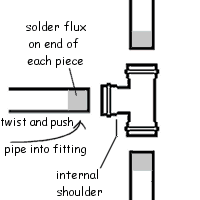 Apply a thin coating of solder flux around the pipe: It is best to use a small brush as the solder flux normally contains some form of acid, so keep it away from your skin.
Apply a thin coating of solder flux around the pipe: It is best to use a small brush as the solder flux normally contains some form of acid, so keep it away from your skin.
Assemble the remaining pipes into the body of the connector. Never try to fit and solder each pipe separately.
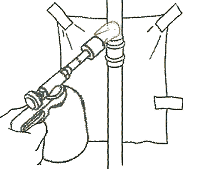 If necessary place a heat screen behind the connector to protect the surrounding surfaces from the blow torch.
If necessary place a heat screen behind the connector to protect the surrounding surfaces from the blow torch.
Light the blowtorch and allow it to burn for a minute or two. This allows the nozzle to heat up, and reduces the chance of the flame flaring up when the torch is tilted. Adjust the flame so that the centre is bright blue.
Two types of fittings are available. Standard plain fittings and integral solder type.
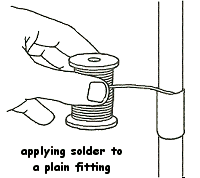 Standard plain fittings (which do not have built-in solder). Unroll a length of solder (so you don't need to get too near the heated pipes). Gently and evenly apply heat to the whole joint, play the flame across each joint and all around them. As soon as the flux begins to bubble, apply the end of the solder to the joint, touch the solder onto three or four places around the fitting, capillary action will draw the solder in between the pipe and the fitting. Gently wipe a damped cloth around each joint to smooth the solder.
Standard plain fittings (which do not have built-in solder). Unroll a length of solder (so you don't need to get too near the heated pipes). Gently and evenly apply heat to the whole joint, play the flame across each joint and all around them. As soon as the flux begins to bubble, apply the end of the solder to the joint, touch the solder onto three or four places around the fitting, capillary action will draw the solder in between the pipe and the fitting. Gently wipe a damped cloth around each joint to smooth the solder.
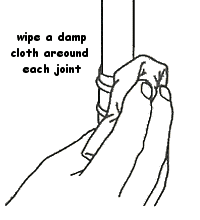 Integral solder type. These are worked in a very similar fashion except that the solder is already in place and as soon as sufficient heat has been applied, it will be drawn from its groove into the narrow gap between fitting and pipe.
Integral solder type. These are worked in a very similar fashion except that the solder is already in place and as soon as sufficient heat has been applied, it will be drawn from its groove into the narrow gap between fitting and pipe.
As before, remember to apply heat gently and evenly. As soon as a ring of solder appears in the gap between, remove the heat source. Continued application of heat can cause the solder to drain out of the joint altogether. Gently wipe a damped cloth around each joint to smooth the solder.
Allow to cool.
Repairing leaking soldered joints
If you are unlucky enough to find that a solder joint leaks when the water is turned back on, all is not lost.
Turn off the water and drain the section of pipe - if water is left in the pipe, the heat applied will be absorbed by the water and the joint will not be heated enough to melt the solder. Apply a little heat to the joint to make quite sure it is dry again. Heat up the joint again and apply a little solder from the end of the reel around the leaking joint. This will work with both types of soldered connection.
If you a really unlucky and the joint still leaks, You will need to drain down again and remove the joint. Heat it up and dismantle the joint whilst wearing some form of heatproof gloves. You now have two options. Clean the pipes thoroughly and use a new solder fitting or, if your feeling totally disheartened, clean up the pipework and fit a compression joint !
